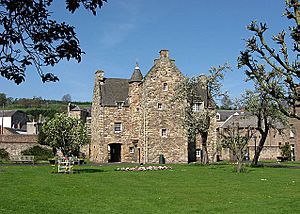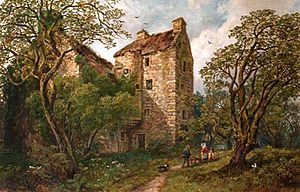Mary Queen of Scots House facts for kids
Quick facts for kids Queen Mary's House |
|
|---|---|

Mary Queen of Scots' House, Jedburgh
|
|
| Type | towerhouse |
| Location | Jedburgh |
| Built | 16th century |
Queen Mary's House is an old building in Jedburgh, Scotland. It was built in the 1500s. People say that Mary, Queen of Scots, stayed here for a few weeks in 1566. Today, it is a museum that opened in 1930. The museum mainly tells the story of Queen Mary's life.
History of Queen Mary's House
This house was built in the 1500s in the town of Jedburgh. It is located close to the Jed Water river. The first way to enter the house was probably from Canongate Bridge. This area is now part of the garden.
A famous artist and astronomer, Nathaniel Everett Green, once drew the house.
In 1777, Dr. Lindsay and his wife, Jean, lived in the house. Ten years later, their daughters helped Robert Burns, a famous poet, when he visited Jedburgh. Dr. Lindsay's grandson, Robert Armstrong, later owned the house around 1819. He was a soldier who joined the Russian army. He even became the head of the Saint Petersburg Mint, which made coins.
Robert allowed his aunts to live in the house until 1869. That is when Elizabeth Armstrong, one of his aunts, passed away.
The artist Arthur Perigal the younger painted the house in 1879. His painting made the house look like it was in the countryside. However, it has always been in the middle of the town.
In 1928, a man named F. S. Oliver gave the building to the town. He was a director at Debenhams and lived nearby. The house was fixed up by an architect named John Wilson Paterson. Mrs. Oliver officially opened it to the public in 1930. In 1971, it became a very important historical building.
What the House Looks Like
Queen Mary's House is made of stone and has three floors. It also has a tall tower with four floors. The roof was first made of straw, then tiles, and now it has grey slate.
You can visit the building for free. Inside, you can walk up a stone spiral staircase to see the rooms. Each room has old items and signs that explain the house's history. They also tell about Queen Mary's life. The large garden has pear trees that were planted recently. These trees are like the ones grown in Jedburgh long ago. Growing pears was once a big part of the town's farming.
Queen Mary's Visit to Jedburgh
Mary, Queen of Scots, came to Jedburgh in October 1566. She brought many people with her to hold a special court. This court lasted from October 9 to November 8. The people in charge rented a house from Lady Ferniehirst for the Queen.
While in Jedburgh, Queen Mary heard that James Hepburn, 4th Earl of Bothwell, was hurt. He was at Hermitage Castle after a fight. She took a risky trip to see him and came back feeling very sick. She often felt a pain in her side. Special fruits like pomegranates and lemons were sent from Edinburgh for her.
Mary's husband, Darnley, was away hunting. When he heard the news, he supposedly came to Jedburgh. However, he was not welcomed. Some old records say that Mary asked her half-brother's wife, Agnes Keith, to pretend he was sick. This was so Darnley would not come to Jedburgh. Darnley was said to have stayed one night in Jedburgh with a local gentleman. Then Mary told him to go to Stirling Castle.
The French ambassador, Philibert du Croc, arrived in Jedburgh on October 15. He was told by Mary to follow her there. Records show that several important people were with Mary in Jedburgh.
On October 25, 1566, a group called the Privy Council of Scotland met in Jedburgh. They announced that everyone must behave well while Mary was sick. No one was allowed to fight or carry weapons. Important leaders like Huntly, Moray, Bothwell, Atholl, and Rothes were at this meeting.
An English border guard heard that there was a fire in Mary's lodging. She had to move to another place. New clothes made of red silk were sent from Edinburgh for her. Mary also ordered food to be sent to Hermitage Castle.
After she got better, Mary rode to Kelso, Scottish Borders. She also visited Wark on Tweed Castle and Berwick-upon-Tweed near the English border. Mary later said she wished she had died in Jedburgh. This was because her life became much worse after that. She was forced to give up her throne. She tried to escape to England, but she was put in prison. Much later, she was executed. For the last thirty years, Queen Mary's House has shared this important story.



